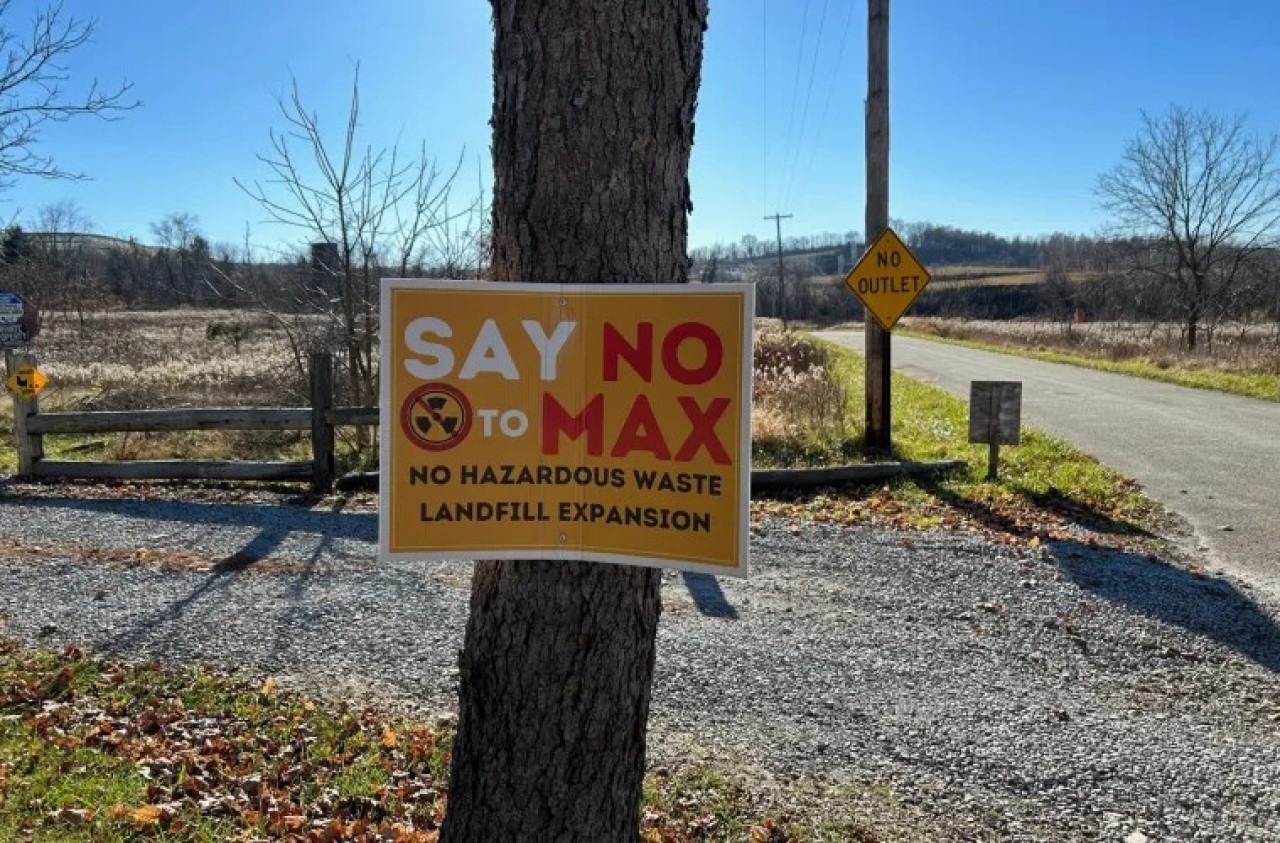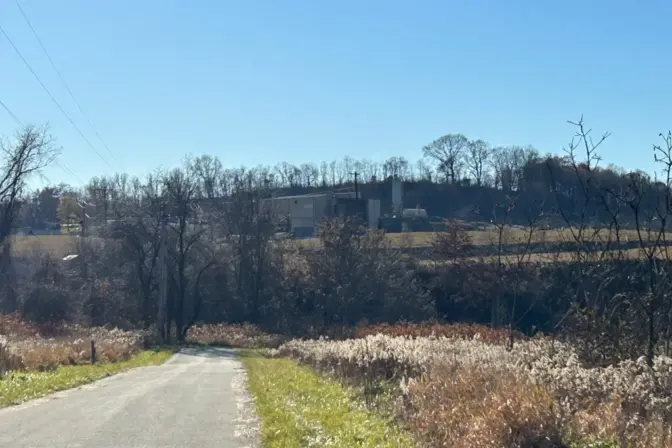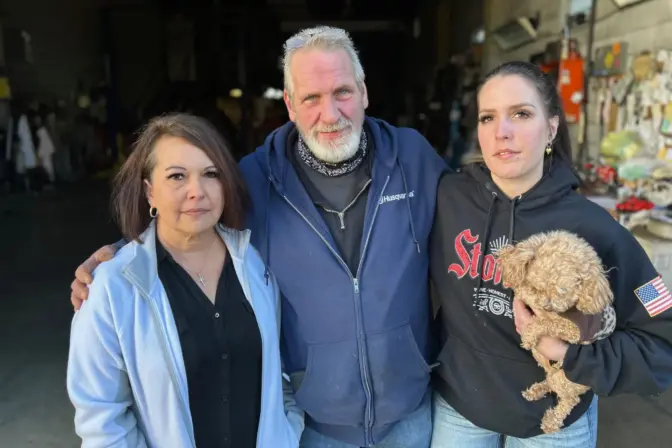
Many residents of Yukon, Pa., were unhappy about an expansion plan for MAX Environmental's hazardous waste landfill. The plan was withdrawn earlier this year.
Reid Frazier / The Allegheny Front


Many residents of Yukon, Pa., were unhappy about an expansion plan for MAX Environmental's hazardous waste landfill. The plan was withdrawn earlier this year.
Reid Frazier / The Allegheny Front

Reid Frazier / The Allegheny Front
Many residents of Yukon, Pa., were unhappy about an expansion plan for MAX Environmental's hazardous waste landfill. The plan was withdrawn earlier this year.
For years, residents have complained about the MAX Environmental hazardous waste landfill in the tiny town of Yukon, Westmoreland County. A federal environmental investigation recently found the landfill may be breaking several federal environmental laws.
In March, investigators with the US EPA’s National Enforcement Investigation Center paid a visit to the landfill.
Over several days, they pulled records, took samples, and examined facilities that treat and store hazardous waste.
The investigators found nearly two dozen instances where the landfill appeared to be violating federal hazardous waste and clean water laws. These included improper treatment of hazardous waste, leaks and spills, and subpar protection of toxic waste piles.
An EPA spokesperson said the agency does not comment on “potential or pending enforcement actions.”
The Pennsylvania Department of Environmental Protection declined to comment on the report, but said it was conducting its own investigation of the facility.
Pennsylvania DEP spokesperson Lauren Camarda said the agency’s clean water and waste management program staff “attended the investigation with EPA, and DEP” and has received the NEIC report.
James Cato, an organizer with the Mountain Watershed Association, which has advocated on behalf of Yukon residents against the landfill, called the evidence compiled in the EPA report ‘shocking’.
“And yet, at the same time, I’m not surprised,” Cato said.
Residents his group has worked with have complained about odors and runoff from the landfill for years.
Mountain Watershed recently found the investigative report in public records on file with the Pennsylvania Department of Environmental Protection.
“This was a sort of window into something that we’ve always wondered, which is like, what if we could get up there and actually see what’s going on at this facility?” he said. “We don’t have the ability to do that. However, this sheds light on a lot of the concerns that the community has had.”

The MAX Environmental facility sits on a hill in Yukon, Pa. Photo: Reid R. Frazier / The Allegheny Front
Carl Spadaro, a spokesperson for MAX Environmental Technologies, Inc., the landfill’s owner, said the company disagrees with the EPA’s assertion that it is improperly treating its waste.
“Our data shows that we treated the waste at issue properly and in accordance with our waste permits,” Spadaro said in an email. “We test each batch of treated waste. Our laboratory is (Pennsylvania) DEP accredited. We carefully review each laboratory report we generate to make sure it is accurate.”
The landfill was first opened in the 1960s to take waste from the region’s steel industry. In 2017, the landfill was bought by the private equity firm Altus Capital Partners.
The EPA lists the Yukon landfill as a “Significant Noncomplier” of the federal Resource Conservation and Recovery Act, which regulates hazardous waste disposal. The landfill had “significant violations” of the RCRA in two of the last 12 quarters, and five of the last 12 quarters for the Clean Water Act, according to EPA data.
MAX is still permitted to dispose of hazardous waste in the landfill after treating it to make it less toxic.
The EPA investigators found that treated waste was still too toxic to be buried. The waste they sampled failed to meet federal standards for the heavy metals lead, cadmium, and thallium. One sample had 1300 times the allowable limit for cadmium, which the EPA classifies as a probable human carcinogen.
“Something’s happening that’s causing their waste to still be hazardous after treatment,” Cato said. “So something’s going wrong there.”
The investigators also found that a waste storage building had holes in the roof and ‘‘large openings in the exterior walls.” They observed rainwater landing on piles of hazardous waste and pooling on the building’s floor, in violation of the company’s environmental permits.
–A leak detection system in one corner of the containment building was covered by backfill and inaccessible to staff. Workers told investigators that the current leak detection inspection method is to “visually inspect the area” where a protective membrane attaches to an outer wall of the building.
–A leak of hazardous leachate, or landfill runoff, in a container inside a wastewater treatment area. Investigators wrote: “Liquid from the container was leaking onto the storage area’s concrete pad and mixing with a puddle of rainwater that had accumulated at the southeast corner of the pad.”
–Instead of taking several samples of waste with a shovel or scoop when testing waste, landfill staff were observed taking one sample by hand. “NEIC inspectors observed that MAX operators were only using a nitrile-gloved hand to collect incoming or treated waste from the excavator bucket into the sample pail.”
–Insufficient pH treatment of wastewater. Investigators wrote that due to equipment limitations, “the facility is not getting complete treatment, which can result in exceedances of effluent limitations for metals.”
Spadaro, in an email, said the company disagreed with the EPA’s finding that its containment building “does not meet hazardous waste regulations and that its wastewater treatment plant “is not being operated in a manner required” by the company’s environmental permits.
“[T]he design and construction [of the building] were approved by a third-party professional engineer and DEP,” Spadaro said. “Furthermore, DEP has been inspecting the Yukon monthly for the 14 years since the containment building was placed in operation. EPA also inspected the containment building in 2011. Neither agency eve[r] indicated to us that the building did not meet required regulations.”
Spadaro said the company did “agree that some repair work on the building exterior is needed” and has been “in the process of getting the necessary repair work done.”
“We have also revised some of our operational plans, provided additional training to facility personnel, conducted more detailed facility inspections where needed, and hired a third-party engineering consultant to evaluate the condition of some of our infrastructure to see if improvements may be necessary,” he said.
Spadaro said the company operates its wastewater treatment system under the state’s pollution discharge permit program.
“DEP typically performs annual inspections of our wastewater treatment plant and has not indicated in their past inspection reports that the plant is not being operated properly,” Spadaro said.

Donna Hoadwonic (left) and James and Katie Cross outside James’ auto repair shop in Yukon. They want the landfill shut down. Photo: Reid R. Frazier / The Allegheny Front
The report’s findings did not surprise Katie Cross, 28, of Yukon. She grew up in the town, a few hundred yards from the landfill.
Her twin sister Jessie has multiple sclerosis. Her father, James, a mechanic, lost his voice box to throat cancer.
She can reel off names of people who have died of cancer, COPD, and other ailments and suspects the hazardous landfill is to blame.
She and others in the town packed a hearing last year to oppose the landfill’s expansion plan, which it ultimately withdrew. After seeing the report, she thinks the landfill should be shut down.
“It sounds like it should be shut down that day,” Cross said. “You’re not following any of your regulations. You’re doing all these violations, and you’re still operating. And it doesn’t seem like anything’s happening.”
Her father’s girlfriend, Donna Hoadwonic, 56, has lived in and around Yukon all her life. She doesn’t think a landfill that takes hazardous waste should be allowed to remain so close – within 500 feet of some houses – to a small town. She recently lost her mother to cancer and knows of many others in town who have also died of cancer.
“That place smells the worst,” she said. “They should be made to clean this crap up and take it away from here.”
Cato, of Mountain Watershed, said he hopes the investigation will result in some type of enforcement action.
“I’m glad that folks have turned an eye toward this facility, which residents have said is a problem for so long,” he said. “It turns out the residents are right. It is a problem. Okay, now, what are we going to do about it?”
StateImpact Pennsylvania is a collaboration among WITF, WHYY, and the Allegheny Front. Reporters Reid Frazier, Rachel McDevitt and Susan Phillips cover the commonwealth’s energy economy. Read their reports on this site, and hear them on public radio stations across Pennsylvania.
(listed by story count)
StateImpact Pennsylvania is a collaboration among WITF, WHYY, and the Allegheny Front. Reporters Reid Frazier, Rachel McDevitt and Susan Phillips cover the commonwealth’s energy economy. Read their reports on this site, and hear them on public radio stations across Pennsylvania.
Climate Solutions, a collaboration of news organizations, educational institutions and a theater company, uses engagement, education and storytelling to help central Pennsylvanians toward climate change literacy, resilience and adaptation. Our work will amplify how people are finding solutions to the challenges presented by a warming world.